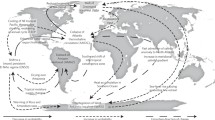Abstract
In this paper we extend our earlier work with the Carbon Emissions Trajectory Assessment model (CETA) to consider a number of issues relating to the nature of optimal carbon emissions trajectories. We first explore model results when warming costs are associated with the rate of temperature rise, rather than with its level, as in our earlier work. We find that optimal trajectories are more strongly affected by the degree of non-linearity in the warming cost function than by whether the cost function is driven by the warming level or the warming rate. Next we briefly explore the implications of simple uncertainty and risk aversion for optimal emissions trajectories. We find that uncertainty and risk aversion cause optimal emissions trajectories to be somewhat lower, but that the effect is not noticeable in the near term and not dramatic in the long term; the long term effect on the shadow price of carbon is more marked, however. Finally, we experiment with scaling up the warming cost functions until optimal policies are approximately the same as a policy of stabilizing emissions at the 1990 level. Based on the results of this experiment, we conclude that damages would have to be very high to justify anything like a stabilization policy; and even in this case, a policy allowing intertemporal variation in emissions would be better.
Similar content being viewed by others
References
Dickinson, R. E. and Cicerone, R. J.: 1986, ‘Future Global Warming from Atmospheric Trace Gases’,Nature, January, 109–115.
Energy Modeling Forum: 1991, ‘Study Design for EMF12 Global Climate Change: Energy Sector Impacts of Greenhouse Gas Emission Control Strategies’, Draft, Stanford University Energy Modeling Forum, Stanford, CA.
Fulkerson, W., Judkins, R. R., and Sanghvi, M. K.: 1990, ‘Energy from Fossil Fuels’,Scient. Amer., September, 128–135.
Intergovernmental Panel on Climate Change: 1990, ‘Policymakers Summary of the Scientific Assessment of Climate Change’, Report to IPCC from Working Group 1, Meteorological Office, Bracknell, U.K., June.
Maier-Reimer, E. and Hasselmann, K.: 1987, ‘Transport and Storage of CO2 in the Ocean - An Inorganic Ocean-Circulation Carbon Cycle Model’,Climate Dynamics 2, 63–90.
Manne, A. S. and Richels, R. G.: 1992,Buying Greenhouse Insurance: The Economic Costs of CO 2 Emission Limits, MIT Press, Cambridge, MA.
Miller, A. C. III and Rice, T. R.: 1983, ‘Discrete Approximations of Probability Distributions’,Managem. Sci. 29(3, 352–362.
National Academy of Sciences: 1991,Policy Implications of Greenhouse Warming, National Academy Press, Washington, D.C.
Nordhaus, W. D.: 1982, ‘How Fast Should We Graze the Global Commons?’,Amer. Econ. Rev.
Nordhaus, W. D.: 1990a, ‘To Slow or Not to Slow: The Economics of the Greenhouse Effect’, February 5.
Nordhaus, W. D.: 1990b, ‘Contribution of Different Greenhouse Gases to Global Warming: A New Technique for Measuring Impact’, February 11.
Nordhaus, W. D.: 1993, ‘Rolling the “DICE”: An Optimal Transition Path for Controlling Greenhouse Gases’,Resourc. Energy Econom. 15(1, 27–50.
Peck, S. C. and Teisberg, T. J.: 1992, ‘CETA: A Model for Carbon Emissions Trajectory Assessment’,Energy J. 13(1, 71–91.
Peck, S. C. and Teisberg, T. J.: 1993, ‘Global Warming Uncertainties and the Value of Information: An Analysis Using CETA’,Resourc. Energy Econ. 15(1, 71–97.
Post, W., Peng, T., Emanuel, W., King, A., Dale, V., and DeAngelis, D.: 1990, ‘The Global Carbon Cycle’,Amer. Scient. 78(4, 310–326.
Richels, R. and Edmonds, J.: 1993, ‘The Economics of Stabilizing Atmospheric CO2 Concentrations’, draft, Electric Power Research Institute, November 2.
Schlesinger, M. E. and Jiang, X.: 1990, ‘Simple Model Representation of Atmosphere-Ocean GCMs and Estimation of the Time Scale of CO2-Induced Climate Change’,J. Clim. 3, 1297–1315.
Wuebbles, D. J. and Edmonds, J.: 1988,A Primer on Greenhouse Gases, U.S. Department of Energy, DOE/NBB-0083, March.
Author information
Authors and Affiliations
Additional information
This paper does not represent the position of EPRI or of its members.
Rights and permissions
About this article
Cite this article
Peck, S.C., Teisberg, T.J. Optimal carbon emissions trajectories when damages depend on the rate or level of global warming. Climatic Change 28, 289–314 (1994). https://doi.org/10.1007/BF01104138
Received:
Revised:
Issue Date:
DOI: https://doi.org/10.1007/BF01104138




